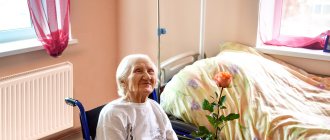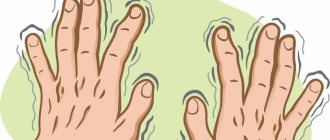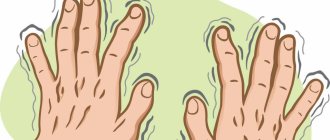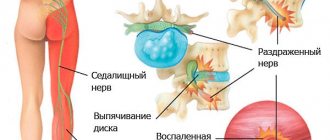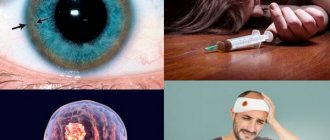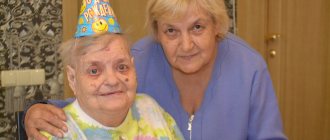Parkinson's disease is a degenerative neurological disease. The disease is characterized by the death of brain neurons that produce dopamine. A decrease in dopamine production leads to various disturbances in the functioning of the brain and nervous system: motor activity is limited, muscle rigidity develops, the patient’s posture changes, and muscle tremors appear. The disease cannot be cured, and the life expectancy of patients is reduced. Treatment of the disease is carried out with the help of drug therapy, surgical treatment, the introduction of stem cells, and physical therapy plays an important role.
The main specialization of the Yusupov Hospital is rehabilitation in neurology, oncology, and palliative care. The rehabilitation department provides classes for patients suffering from Parkinson's disease. Rehabilitation specialists develop individual programs for patients, and instructors conduct classes.
The influence of exercise therapy on the physiological state
The exercises of the complexes are usually selected by a qualified instructor, taking into account the capabilities and needs of the patient. When they are performed, the body systems are strengthened: digestive, cardiovascular, skeletal and others. It is better for a patient to engage in exercise therapy under the supervision of loved ones or a specialist - the second option is preferable. The benefits of the exercise will be noticeable after just a few sessions:
- “rest tremors” decreases;
- muscle stiffness is less pronounced;
- movements become more purposeful, the effect of inhibition disappears;
- muscle stagnation is eliminated, thereby expanding the range of movements;
- pain in joints and muscle tissue goes away.
With regular exercise, it is possible to reduce the physiological manifestations of Parkinson's disease. The patient begins to move better and more confidently, maintains an even posture, his gait becomes the same, he maintains his balance more stably. Many people trust private rehabilitation centers and boarding houses to care for elderly patients and those in the prime of life. This is the right decision, because hospitals of this type have all the conditions for a quick recovery.
Deep breathing
Goal:
to achieve deeper breathing through exercise.
In a sitting position. Place your hands on your stomach. Take a slow, deep breath through your nose, feel how your chest expands and your stomach “inflates.” Then slowly, counting to 5, exhale through your mouth, as if blowing out a candle. Repeat 10 times. In a standing position. Go to the wall. Stand so that your entire back and lower back feel the wall or other vertical surface: closet, door, etc. Raise your hands up and, touching the wall with them, take a deep breath; As you exhale, lower your arms down and cross them in front of your chest and stomach so that your right hand grabs the elbow of your left hand and vice versa. Repeat 10 times.
What problems do you have to deal with?
The degree of impairment of physiological functions depends on the duration of the disease. If an active person suddenly gets sick, this is not a reason to give up his favorite activities - tennis, cycling, playing football. With properly selected drug therapy, the patient will be able to feel equal in society with other people for a long time.
Those who led a “sedentary” lifestyle need more attention - such patients need to be given more attention: they should definitely systematically engage in physical therapy. It is advisable that a specialist develop a set of exercises - he will take into account body weight and height, muscle volume, as well as chronic diseases (if any). The more active the lifestyle of a patient with Parkinson's disease, the more successfully he will be able to fight this dangerous disease.
general information
Parkinson's disease affects men twice as often as women. In most cases, it develops after 60 years of age, but cases of early onset of the disease are recorded (at 30-40 years of age), as well as juvenile forms that develop in people in their twenties.
There are several hypotheses for the formation of pathology. It has now been precisely proven that one of the mechanisms of its development is the gradual degeneration of neurons and a decrease in the production of dopamine. It is an important neurotransmitter involved in the transmission of nerve impulses. As a result, a specific set of disorders is formed, which makes it easy to make a diagnosis.
Training mode
When classes are supervised by a specialist, fewer problems arise. If a patient practices under the supervision of relatives, they often force things, trying to act in accordance with recommendations read on the Internet or in books. From the first days, seriously loading the patient, they contribute to his breakdown. Coordination of the training program with an experienced physical therapy specialist is mandatory. The following points will be discussed:
- duration of classes;
- level of physical activity;
- a set of exercises taking into account the individual characteristics of the patient;
- frequency of training;
- other nuances.
All this will help to avoid overworking the patient, adapt him to the loads, and pay more attention to special exercises. Today, many nursing homes in Moscow focus on the rehabilitation of patients with Parkinson's disease - by placing your relative in a specialized institution, you can more effectively fight the disease.
Parkinson's disease and approaches to its treatment
Fedotova E.Yu., Ivanova E.O. The first description of patients suffering from this disease belongs to James Parkinson, who since 1817 in his “Essay on the Shaking Palsy” described 6 patients with similar clinical symptoms. Of the four main signs by which diagnosis is made today, he described three: resting tremor, hypokinesia and postural instability. A little later, Jean Martin Charcot added a fourth symptom to the description, rigidity, and called shaking paralysis “Parkinson's disease.” In 1912, Frederick Henry Levy described intracellular inclusions in the central nervous system, characteristic of Parkinson's disease (PD), and 7 years later, our compatriot Konstantin Nikolaevich Tretyakov first showed that the main target of the neurodegenerative process in PD is the substantia nigra of the midbrain. The most important milestone in the study and treatment of PD was the 1960s, when levodopa, a dopamine precursor, began to be used to treat this disease.
The prevalence of PD varies from study to study and is estimated to be approximately 100–250 cases per 100,000 population. PD is an age-dependent disease, that is, it mainly affects older people. Thus, among people over 60 years of age, the prevalence of the disease can reach 1–2%. According to some data, men get sick about one and a half times more often than women. In addition to age and gender, risk factors include living in rural areas, contact with herbicides, pesticides, and heavy metals.
Pathogenesis and diagnosis of Parkinson's disease
PD is a synucleinopathy, that is, during a neurodegenerative process, there is intracellular accumulation of the protein alpha-synuclein in the form of so-called Lewy bodies. At the initial stages of the disease, Lewy bodies are found only in the peripheral nervous system, in particular in the cells of the Meissner and Auerbach plexuses of the gastrointestinal tract, then as the pathological process spreads - in certain nuclei of the trunk and in the substantia nigra, and at advanced stages - in the cortex of the large hemispheres. The topical spread of the neurodegenerative process is accompanied by corresponding clinical manifestations: before damage to the substantia nigra - non-motor manifestations, and after the death of more than 70% of nigral neurons - already motor symptoms [1].
The main motor manifestations of PD, as already noted, include hypokinesia, resting tremor, rigidity and postural instability. It is their presence that allows a diagnosis of PD to be made according to the generally accepted criteria of the United Kingdom Parkinson disease Society Brain Bank Criteria. PD is not limited only to motor disorders; its clinical spectrum also includes a very specific set of non-motor disorders, which began to be carefully studied and researched relatively recently. They are represented by sensory, dyssomnic, cognitive, emotional-affective, behavioral, psychotic, autonomic-visceral disorders. It is believed that long before the onset of the diagnostic stage of PD, before the appearance of motor manifestations, a number of non-motor symptoms can be identified in such patients, in particular, depression, constipation, sleep disturbance, hyposmia and some others. It is the premotor stage that is a potential “therapeutic window” when it is possible to carry out effective neuroprotective therapy to prevent or slow down the development of this disease. Transcranial sonography can be used as an instrumental diagnostic method, which allows diagnosing the phenomenon of hyperechogenicity of the substantia nigra (SN), characteristic of PD. This method can be useful for differential diagnosis between PD and parkinsonism-plus syndromes, however, the phenomenon of HFS does not have absolute diagnostic significance and should be interpreted in conjunction with the rest of the clinical picture.
Treatment of Parkinson's disease
Drug therapy for motor manifestations of Parkinson's disease
At the moment, there is not a single drug that has proven neuroprotective properties in PD, therefore symptomatic therapy is carried out, as well as physical and socio-psychological rehabilitation, and in some cases neurosurgical treatment is used. Below we will look in more detail at the groups of antiparkinsonian drugs used in the treatment of motor manifestations of PD: levodopa drugs, dopamine receptor agonists (DRAs), amantadine drugs, monoamine oxidase type B inhibitors (MAO-B) and anticholinergic drugs.
Levodopa drugs are the “gold standard” in the treatment of PD, although they have certain limitations in the form of side effects and complications during long-term therapy. It has been proven that monotherapy with levodopa is more effective than monotherapy with ADR. It is widely practiced to add levodopa to other antiparkinsonian drugs to more effectively control the symptoms of PD. Levodopa has a short half-life, so most often treatment with this drug is started with three doses, subsequently increasing the frequency of dosing and adjusting single doses as the disease progresses and motor complications appear. The main effect of levodopa is to replenish the dopamine deficiency observed during the death of nigrostriatal neurons. Dopamine itself is not able to penetrate the blood-brain barrier (BBB), therefore, to treat PD, its immediate precursor that penetrates the BBB, levodopa, is used, which is converted into dopamine by decarboxylation. In order to block the decarboxylation of levodopa in the periphery and increase the concentration of levodopa in the brain, levodopa is used in combination with a peripheral DOPA decarboxylase inhibitor, carbidopa or benserazide [2, 3]. Decarboxylation is not the only way levodopa is metabolized. Levodopa can be methylated by the enzyme catechol-o-methyltransferase (COMT), so in some cases a catechol-o-methyltransferase inhibitor, tolcapone or entacapone, is added to increase the bioavailability of levodopa. In Russia, a combination of levodopa/carbidopa/entacapone with several dosages of levodopa is used to treat PD. In addition to standard dosage forms, a controlled-release dosage form of levodopa is also used, characterized by a longer half-life. This form is prescribed to patients with motor fluctuations, as well as at night to correct nocturnal akinesia. It should be noted that, compared with ADR and amantadine, levodopa is characterized by a lower risk of developing hallucinations and psychosis, and therefore is the drug of choice for patients with cognitive impairment [2, 3].
Dopamine receptor agonists used to treat PD have an antiparkinsonian effect due to their action on D2 receptors. Drugs from this group can be used in combination with levodopa and other antiparkinsonian drugs, and can be prescribed as the first drug in treatment, more often in young patients. Currently, non-ergoline agonists are used in practice, which include piribedil, pramipexole, ropinirole (used orally), rotigotine (patch), and apomorphine (for subcutaneous administration) is being prepared for registration. There are dosage forms of ropinirole and pramipexole with controlled release for use once a day, due to which greater compliance with treatment is achieved, as well as better tolerability of the drugs. Prescription of rotigotine, presented in the form of a transdermal patch, is possible for people who, for one reason or another, have difficulty taking medications orally. The most common side effects of ADR are nausea, vomiting, orthostatic hypotension, swelling of the legs, mental disorders (daytime sleepiness, psychosis, hallucinations); in young patients, in some cases, the development of impulsive-compulsive disorders is possible [2–4].
Along with levodopa and ADR drugs, amantadine drugs (amantadine chloride or amantadine sulfate) are often prescribed for the treatment of motor symptoms of PD. Amantadine is characterized by a moderate symptomatic effect and is therefore mostly used in combination with drugs from other groups. Amantadine drugs have anti-NMDA activity, inhibit the reuptake of dopamine and promote its release. There is an infusion form of amantadine sulfate, which can be used in conditions of acute decompensation of PD, accompanied by symptoms of dysphagia. Side effects are usually mild and include nausea, peripheral edema, dry mouth, livedo reticularis, and several others. The anticholinergic effect of amantadine limits its use in patients with dementia and hallucinations [2, 3].
Monoamine oxidase type B inhibitors interfere with the metabolism of dopamine, thereby increasing its concentration in the synaptic cleft. Representatives of this group - selegiline and rasagiline - can be used as monotherapy in the early stages of the disease with minimally severe symptoms or in combination with other drugs. It should be noted that, compared with other antiparkinsonian drugs, monoaminooxidase inhibitors have a weak clinical effect and therefore in most cases are used as an addition to primary therapy. In recent years, preference has been given to rasagiline due to the lower incidence of side effects and more pronounced clinical effect. In addition, according to the ADAGIO study, it was shown that this drug has neuroprotective properties, which, however, requires further confirmation [5].
Anticholinergic drugs include biperiden and trihexyphenidyl, which are used primarily for tremor resistant to other antiparkinsonian drugs. Side effects of anticholinergic effects, such as dry mouth, urinary retention, cognitive and psychotic disorders, significantly limit their use. It should be remembered that anticholinergic drugs are contraindicated in patients with angle-closure glaucoma, as well as with dementia and hallucinations.
When prescribing antiparkinsonian drugs, their doses and combinations, a number of factors should be taken into account: first of all, the characteristics and severity of motor and non-motor symptoms, the age of the patient, the effectiveness of the drugs in this particular patient, their side effects and, in addition, pharmacoeconomic aspects. For example, at an early age of onset of PD, that is, before 50 years, ADR should be considered as the first drug, while at an age of onset of PD over 70 years, a levodopa-containing drug is first prescribed [3].
Despite the fact that levodopa is the “gold standard” in the treatment of PD, as the disease progresses, most patients develop complications of levodopa therapy—motor fluctuations and drug-induced dyskinesias. Motor fluctuations represent fluctuations in the effect of levodopa. Patients begin to feel the end of the action of the next dose of the drug: at first gradually (the phenomenon of “end-of-dose depletion”), and as it progresses, abrupt and unpredictable (periods of “on/off”). Most patients with motor fluctuations also experience fluctuations in non-motor symptoms: vegetative, mental, sensory. In addition to fluctuations, drug-induced dyskinesias can also develop—excessive, violent movements that occur in most cases at the peak of the action of levodopa/ADR. The appearance of these complications is associated with several mechanisms mediated by disease progression and the direct effect of levodopa. Thus, during the progression of PD, the number of nigrostriatal neurons decreases, and therefore the buffer function of their terminals is lost. Thus, the concentration of dopamine in the synaptic cleft is directly dependent on the concentration of levodopa in the blood. In this case, pulsating stimulation of dopamine receptors occurs, significantly different from physiological tonic stimulation, leading to secondary changes in the postsynaptic apparatus.
Correction of motor fluctuations may include increasing the dose and frequency of levodopa administration, the use of levodopa/ADR slow-release drugs, and the addition of other groups of drugs - COMT inhibitors, MAO-B inhibitors, ADRs. In the presence of dyskinesias, treatment approaches such as reducing the single dose and increasing the frequency of dopaminergic medications, and adding amantadine to the treatment regimen are used [6, 7].
Despite the wide possibilities of oral drug therapy, in advanced stages of PD one often has to deal with resistant forms of complications of levodopa therapy. In these cases, they resort to methods that allow maintaining constant stimulation of dopamine receptors: duodenal administration of levodopa/carbidopa gel through a gastrostomy tube or subcutaneous administration of apomorphine using pumps. Continuous intraduodenal administration of levodopa-containing gel is indicated for motor fluctuations that cannot be corrected by other approaches. Like any invasive treatment, it has a number of disadvantages associated with the need for periodic surgical examination and associated complications. Subcutaneous infusion of apomorphine is less invasive and also allows you to reduce the daily duration of “offs”, however, apomorphine, being an ADR, has all the side effects of drugs of this class, although to a lesser extent.
Surgical treatment of motor manifestations of Parkinson's disease
Neurosurgical methods for the treatment of PD deserve special attention, which are used in three situations: 1) with motor fluctuations and drug-induced dyskinesias resistant to drug therapy; 2) with disabling rest tremor resistant to drug therapy; 3) in cases where dopaminergic therapy is effective, but cannot be carried out due to any other side effects. Neurosurgical treatment of PD is represented by two types of stereotactic interventions: destructive (thalamotomy, pallidotomy) and stimulating (DBS, deep brain stimulation). Destructive operations are, as a rule, unilateral due to the fact that with bilateral destructive intervention the risk of complications, including pseudobulbar syndrome, increases significantly. Thus, the risk of severe dysarthria with bilateral thalamotomy is about 30%. For DBS, three main targets of surgical treatment are considered - Vim (ventrolateral nucleus of the thalamus), STN (subathalamic nucleus), GPi (internal segment of the globus pallidus). The target is selected according to certain indications, for example: the ventrolateral nucleus of the thalamus - for intractable drug-induced tremor, the globus pallidus - for severe drug-induced dyskinesias, the subthalamic nucleus - for motor fluctuations without disabling dyskinesias. It should be taken into account that Vim stimulation does not affect the severity of hypokinesia/rigidity. It is also known that STN stimulation allows for greater dopaminergic drug dose reduction compared to GPi stimulation. The correct selection of candidates for surgical treatment plays a critical role. A necessary condition is an accurately established diagnosis of idiopathic PD lasting more than 5 years (severe disability in patients before this period most likely indicates the presence of “parkinsonism-plus” syndrome). It is necessary to ensure the effectiveness of levodopa in this patient in relation to hypokinesia and rigidity, since the effectiveness of surgical intervention is usually not greater than the effectiveness of levodopa therapy. However, this condition does not apply to drug-resistant tremor, for which the effectiveness of DBS may exceed that of drug therapy. Non-motor manifestations of PD such as dementia and psychotic disorders should be excluded [8]. Complications of functional neurosurgery include: hemorrhage, infectious complications, electrode displacement, psychotic disorders, emotional lability and depression (including suicide attempts), frontal dysfunction, swallowing and speech disorders. However, the severity of complications in most cases is low and is not a reason to refuse surgery in patients selected according to all the necessary criteria [9].
Treatment of non-motor disorders in Parkinson's disease
Various non-motor manifestations of PD can reduce the quality of life of patients no less than motor disorders (especially in advanced stages of the disease), so it is necessary to pay due attention to their drug correction. Below we will consider the main approaches to the treatment of the most common non-motor disorders in PD.
Depression, anxiety. Anxiety and depressive disorders are observed in approximately 40% of patients with PD. Prescribing dopaminergic drugs to correct motor symptoms can reduce the severity of not only motor symptoms, but also anxiety/depression. A number of studies have demonstrated the antidepressant effect of pramipexole. If these symptoms are resistant to dopaminergic therapy, the prescription of antidepressants is indicated. Clinical studies have confirmed the effectiveness of tricyclic antidepressants in the treatment of depression in PD, but the use of drugs in this group is limited due to the risk of adverse reactions. The safer selective serotonin/serotonin and norepinephrine reuptake inhibitors are also used in clinical practice, although their effectiveness has not been confirmed in large studies [10–12].
Dementia, psychotic disorders. If patients have dementia, the first step should be to discontinue medications that negatively affect cognitive function - anticholinergic drugs, amantadine, tricyclic antidepressants, tolterodine and oxybutynin, benzodiazepines. Cholinesterase inhibitors are used to treat dementia: rivastigmine, donepezil, galantamine. Currently, of the three drugs listed above, only rivastigmine has a sufficient evidence base for its effectiveness. Akatinol memantine can be considered as a second-line drug. Often, patients with cognitive impairment (or a high risk of developing it) experience psychotic disorders, most often visual hallucinations. Their correction also involves the abolition of the above-mentioned drugs that affect cognitive functions. If this measure is ineffective, a dose reduction/cancellation of ADRs, MAO-B and COMT inhibitors and, lastly, a reduction in the dose of levodopa is indicated. If necessary, atypical antipsychotics are prescribed in the minimum effective dose - clozapine or quetiapine. Of these, clozapine is more preferable, since it has a large evidence base for effectiveness. Concomitant infectious/metabolic disorders can also provoke the development of psychotic conditions, so we must not forget about their timely detection and correction [11, 12].
Autonomic disorders. The most common autonomic disorders in Parkinson's disease include constipation, gastric dysfunction, orthostatic hypotension, and urinary disorders.
In the treatment of constipation, in addition to prescribing laxatives, diet correction and increased physical activity play an important role. Of laxative drugs, preference should be given to osmotic laxatives and products containing fiber. In case of disturbance of the evacuation function of the stomach with the development of symptoms such as nausea, vomiting, a feeling of fullness and abdominal pain, it is advisable to use domperidone. If a patient has orthostatic hypotension, it is necessary first of all to adjust the dose or discontinue the drugs that provoke it: diuretics and other antihypertensive drugs, nitrates, alpha-blockers. In some cases, it is necessary to resort to correction of the antiparkinsonian therapy regimen, since dopaminergic drugs (most often ADR) can also provoke or aggravate the manifestations of orthostasis. It is necessary to recommend that patients eat meals in small portions, maintain adequate water and salt intake (at least 2 liters of water per day, 1 g of salt per meal), wear compression elastic tights/bandage, and raise the head of the bed to 30–40°. If the above measures are ineffective, fludrocortisone can be added to treatment under monitoring of blood pressure and electrolyte balance.
Sleep disorders often observed in PD are divided into daytime (daytime sleepiness, sudden sleep episodes) and nighttime (REM sleep behavior disorder, insomnia, restless leg syndrome). In case of daytime disturbances, it is recommended to reduce the dose/discontinuity of sedatives, reduce the dose of ADR, or replace it with another ADR. In case of behavioral disorders in the REM sleep phase, it is advisable to reduce the dose/discontinue of antidepressants, reduce the dose of ADR, and if these measures are ineffective, prescribing melatonin or clonazepam in small doses at night may be effective. Insomnia caused by nocturnal akinesia is corrected by adding long-acting dopaminergic drugs to the antiparkinsonian regimen. In other cases, it is advisable to treat with melatonin preparations or antidepressants with a sedative effect.
The overwhelming majority of patients with PD at one stage or another of the disease develop urinary disorders, mainly in the form of detrusor overactivity. The appearance in patients of complaints of frequent urination/urinary incontinence requires the exclusion of other potentially treatable causes - urinary tract infections and diabetes mellitus. Peripheral anticholinergics (trospium chloride, tolterodine, oxybutynin) are used as therapy for bladder overactivity. At the same time, in patients with cognitive impairment, preference should be given to trospium chloride, as the drug that penetrates the BBB to the least extent [11, 12].
Conclusion
Treatment of PD is a rather complex, complex task that requires the doctor to have relevant knowledge, certain experience, as well as observation and patience. In addition to the listed approaches to symptomatic treatment, large-scale research has also appeared in recent years on the use of innovative, pathogenetic drugs, including those based on gene therapy. It is expected that they will enter clinical practice in the next decade, which will fundamentally change the prognosis and quality of life of patients with PD. At the same time, the already available variety of drugs and treatment approaches makes it possible to maximally individualize the treatment regimen for a particular patient, affecting all manifestations of the disease, motor and non-motor symptoms. Correctly selected treatment gives patients the opportunity to maintain the proper level of physical and mental activity for a long time, continue to work, and live a full life.
Literature
- Klingelhoefer L., Reichmann H. Pathogenesis of Parkinson disease - the gut-brain axis and environmental factors // Nat. Rev. Neurol. 2015; 11 (11): 625–636.
- Clinical guidelines for neurology of the European Federation of Neurological Societies / Ed. Gilhus NE, Barnes MP, Brainin M. Ed. Nikitin S. S. Publishing house "ABV-press", 2012. pp. 271–334.
- Illarioshkin S.N. Therapy of parkinsonism: possibilities and prospects // Neurology and Rheumatology. Supplement to the journal Consilium Medicum. 2009. No. 1. P. 35–40.
- Illarioshkin S.N., Ivanova-Smolenskaya I.A., Zagorovskaya T.B. et al. Seven years of experience in using mirapex in patients with various forms of primary parkinsonism // Journal of Neurology and Psychiatry named after. CC Korsakov. 2006; 11:26–32.
- Stowe R., Ives N., Clarke C.E. et al. Evaluation of the efficacy and safety of adjuvant treatment to levodopa therapy in Parkinson's disease patients with motor complications // Cochrane Database Syst. Rev. 2010; 7: CD007166.
- Fox SH, Katzenschlager R, Lim SY et al. The Movement Disorder Society Evidence-Based Medicine Review Update: Treatments for the Motor Symptoms of Parkinson's Disease // Mov. Discord. 2011; 26(Suppl 3):S2–S41.
- Levin O. S. Levodopa-induced dyskinesias in Parkinson's disease: possibilities of prevention and therapy // Modern therapy in psychiatry and neurology. 2015; 3: 15–25.
- Zagorovskaya T. B., Shirshov A. V., Illarioshkin S. N. Algorithm for selecting patients with Parkinson’s disease for surgical treatment using deep brain stimulation // Atmosphere. Nervous diseases. 2010; 3:8–12.
- Duker A., Espay A. Surgical treatment of Parkinson’s disease: past, present and future // Neurol. Clin. 2013; 31(3):799–808.
- Connolly BS, Lang AE Pharmacological treatment of Parkinson's disease: a review // JAMA. 2014; 311(16):1670–1683.
- Seppi K., Weintraub D., Coelho M. et al. The Movement Disorder Society Evidence-Based Medicine Review Update: Treatments for the Non-Motor Symptoms of Parkinson's Disease // Mov. Discord. 2011; 26(Supple 3):S42–S80.
- Lim SY, Lang AE The nonmotor symptoms of Parkinson's disease — an overview // Mov Disord. 2010; 25(Suppl 1):S123–S130.
Attending doctor…
Useful tips
We deliberately do not offer you a ready-made set of exercises - let a rehabilitation specialist develop it for you, but we will share general recommendations:
- you need to practice every day;
- the amount of training depends on the instructions of the neurologist and methodologist; this is largely determined by the patient’s previous (before the illness) lifestyle;
- overload should not be allowed, the best option is a slight feeling of fatigue, which is replaced by cheerfulness;
- exercises should be aimed at all muscle groups, but more attention should be paid to restoring motor ability;
- It is very important to maintain rhythm when performing exercises;
- It is advisable to choose the right time for training - if the patient feels weak in the morning and is active in the afternoon, then he should train after lunch.
Persistence and determination will allow the patient to cope with these difficulties and slow down the progression of Parkinson's disease. This is an opportunity to improve the quality of life, soften the blow dealt by fate!
Exercise to improve posture
Target:
learn to regulate the tension of the muscles of the neck and torso in order to counteract the formation of a “bent posture”.
Stand with your back to the wall, so that the back of your head, shoulder blades, buttocks, thighs and shins touch the wall; arms are placed along the body, palms rest against the wall. Try to “squeeze” into the wall with tension (up to a count of 5), and then you should relax and rest as long as you need. Repeat the exercise several times, try not to interrupt your breathing. Starting position, as in the previous exercise. Remaining “stuck” to the wall with the back of your head, back, buttocks and palms, squat down “sliding” your back along the wall. If you find it difficult to get up afterwards, place a chair nearby or take a stick to lean on. Stand facing the wall so that one cheek is turned to the side, your chest and stomach, your hips seem to “stick” to the wall. Extend your arms at shoulder level and position them so that your palms “stick” to the wall. Raise your palms “sticking” to the wall up above your head. When your palms are above your head, exhale; when they return to shoulder level, inhale. Do the exercise until you feel pleasantly tired.
"Trso Twist"
Target:
improving the mobility of the muscles of the neck, shoulders, and torso. While sitting or standing, place your palms on your shoulders or behind your neck. Turn your head, neck and torso, first in one direction and then in the other, as much as possible. You should feel a slight tension in your torso muscles. Repeat 10 times.
Bending of the torso
Target:
improved posture and improved mobility in the thoracic and lumbar spine.
Sitting on a chair, place your palms on your knees, lean forward, then arch your back and straighten your shoulders. Then sit up straight. Repeat 10 times.
While sitting on a chair, place your hands on the lower back area (“grab yourself by the lower back”). Bend at the waist, sticking your chest forward and straightening your shoulders, counting to “20”. Then sit up straight. Repeat 10 times.
Abdominal exercise
Target:
strengthening the abdominal muscles.
Lying on your back (on the floor, on the bed), bend your knees, placing your feet on the floor (bed). Slowly extend your arms forward and sit down, raising your shoulders and head (while your lower back touches the floor) as many times as you have the strength to do without losing your breath. Touch your hands to your knees. Then return to the starting position. Repeat 10 times.
"Bridge"
Target:
strengthening the muscles of the trunk, thighs and training turns in bed. Lying on your back, bend your knees, placing your feet on the floor (bed), lift your pelvis, leaning on your feet and shoulders, turn left and right. Repeat 10 times.
Push ups
Target:
Stretching the shoulder muscles and improving posture. Stand facing the corner of the room. Place your hands on both walls and lean towards the corner, bending your elbows so that you feel the muscle tension. When bending, do not lift your feet off the floor. Bend over and continue to rest your hands on the walls, count to 20. Then return to the starting position. Repeat 10 times.
Circular movements and bending of the torso Purpose: to improve the mobility of the torso muscles. Starting position: standing, feet shoulder-width apart, hands at the waist. Perform circular movements with your torso (as if you were twirling a hoop), as well as bending forward, backward, and to the sides. Repeat 10 times in each direction. Exercises for the muscles of the neck and shoulder girdle Turning the head to the sides Goal: improving mobility in the cervical spine. While sitting or standing, slowly turn your head from side to side, trying to look behind your shoulder when turning. Turn your head and hold it in this position for a count of 5. You should feel a slight tension in your neck muscles. Repeat 10 times.
Head tilts to the sides
Target:
improved mobility in the cervical spine. In a sitting position. Slowly tilt your head to the sides, towards each shoulder in turn. While bending, try not to turn your head, look forward. With each bend, you should feel a slight tension (“stretch”) in the neck muscles. Perform 10 bends in each direction.
Head tilts forward and backward
Target:
improving posture and reducing the fixed flexion position of the head.
In a sitting or standing position. Bend your neck and push your chin forward.
Then return to the starting position. Repeat 10 times. Lower your head and touch your chin to your chest, return your head to its original position. Repeat 10 times. After this, slowly tilt your head back (if you perform this movement while standing, it is better to play it safe by holding on to a strong, stationary object or a bracket on the wall). Leaning your head back, try to relax your neck muscles and “feel this position.” It should counteract the fixed position of the neck in a flexed position.
Exercises for the muscles of the shoulder girdle
Exercise for alternately tensing and relaxing the muscles of the upper shoulder girdle (“prayer”)
Target:
achieve tension and relaxation of the muscles of the upper shoulder girdle by training.
While sitting or standing, bring your hands together with your palms facing each other.
Strain your arms as hard as you can so that your palms rest against each other. Count to "20". Then relax your arms and “throw” them down. Repeat 5-10 times. Try to record in your memory how you feel when you tense your arms and when you relax them. Try to reproduce the feeling of relaxation when stiffness increases. Shoulder extension (“straighten your shoulders”)
Target:
increased range of motion in the joints of the upper shoulder girdle. While sitting or standing, bend your elbows and move your elbows back, bringing your shoulder blades closer to each other. Hold them in this position for a count of five. Then relax and return your arms to the starting position. Repeat 10 times.
Circular movements in the shoulder joints
Goal: increasing the range of motion in the shoulder joints. While sitting or standing, make circular movements with your shoulders (the shoulder moves up, back, down and forward). Perform together or alternately with each shoulder 5 times. Then repeat circular movements in the opposite direction (down, forward, up, back).
Exercise with a stick
1) raising and lowering
Goal: increasing the range of motion in the shoulder joints. While sitting or standing, take a wooden stick (cane) about 1 meter long with both hands and lift it to chest level. Then try lifting the stick above your head. Next, lower your arms to chest level and then lower your hands to your knees.
Repeat 10 times.
Physiotherapy
Physiotherapy for Parkinson's disease is aimed at improving trophism and strengthening muscle tone. In the initial stages of the disease, the patient can attend procedures in a medical facility. In the later stages of parkinsonism, it is recommended to purchase portable devices for home procedures, having coordinated physical therapy with your doctor.
Nutrition
Diet therapy for parkinsonism is based on the consumption of foods that are easily digested and absorbed. In this case it is necessary:
- drink 1.5 liters of clean water per day;
- eat in modest portions, every 3-4 hours;
- limit salt and sugar.
In the later stages, patients with Parkinson's have impaired chewing and swallowing functions, and uncontrolled drooling appears. To prevent a person from going hungry, you need to properly organize meals, or hire a nurse who has the skills to feed helpless patients.

